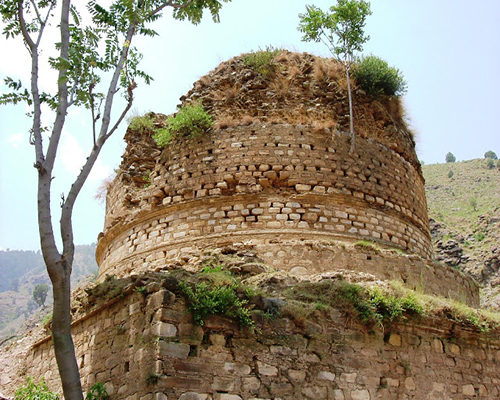Gumbatona Buddhist Stupa- Pakistan

Address
Gumbatona Buddhist Stupa- Gumbatona Swat, Khyber Pakhtunkhwa, Pakistan
Diety
Buddha
Introduction
The site of Gumbatuna (Gumbatuna is the form of Gumbat, the Pashto word for dome) is a Buddhist establishment situated on the right bank of the river Swat, 6km west of Barikot village along the metalled road leading towards Nimogram in a wide valley. The valley is broadly drained by the Swat river which flows in several braided channels through the area. The archaeological remains are scattered over a range of 1500 meters north to south and 1000 meters east to west in wides terraced fields sloping unto the hills behind, known as Shamozai range. The excavation of the first season was limited only to the terraces, which comprise the huge main stupa, and the votive stupas partially uncovered by the treasure hunters. The middle terrace is composed of circular monastery now occupied by the modern village of Gmbatuna. The upper terrace is composed of different group of monastic settlements, caves, viharas and stupas.
Puranic Significance
The main stupa was surrounded by 27 votive stupas of different sizes, square in plan, all composed in the styles of diaper masonry. The floor around these stupas was paved with slabs of schist stone. The upper parts of the votive stupa are missing except votive stupa No.16 and 27 which exist up to the drum. The facing of the plinth built in diaper style in plain in case of some stupas, while stupa numbers 14, 15 and decorated with Corinthian pilasters. The excavations at Gumbatuna were limited to the northern, southern and western sides. The area in front of the main stupa has yet to be excavated in order to complete the salvage operation at the site. The excavations were limited, as also the sculpture robbers had disturbed the site and removed the antiquities, although a good number of sculptures and an impressive stupa complex were uncovered. These sculptures include Buddha, Bodhisattvas, architectural elements in stone and stucco. The site has yielded no coins which could have helped in providing clue to absolute dating. Nonetheless, the sculptures in stone, stucco and the diaper masonry seem to belong to the early Kushana era. Therefore, it seems probable that the Gumbatuna site flourished during the 2nd century A.D. and lasted until the 7th-8th century A.D.
Century/Period/Age
2nd century A.D.
Managed By
UNESCO world heritage site
Nearest Bus Station
Gumbatona
Nearest Railway Station
Landi Kotal station
Nearest Airport
Peshawar









